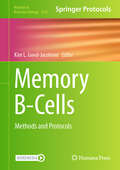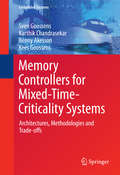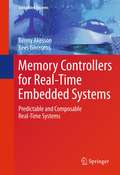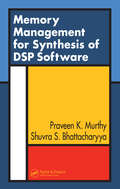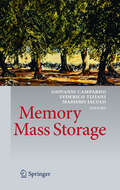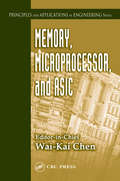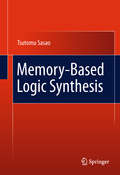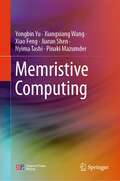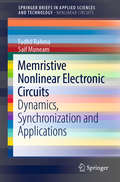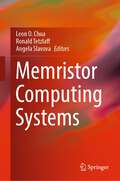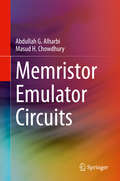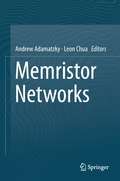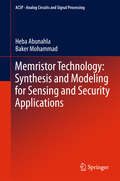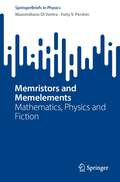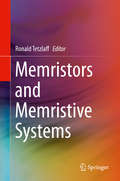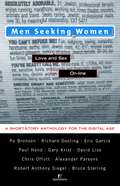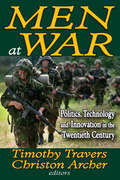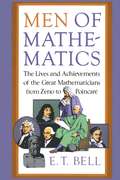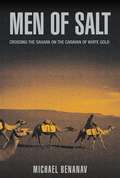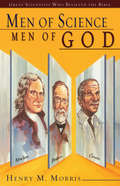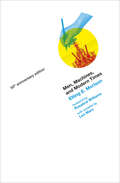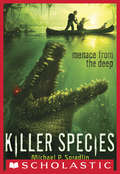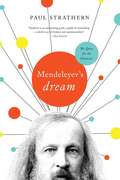- Table View
- List View
Memory B-Cells: Methods and Protocols (Methods in Molecular Biology #2826)
by Kim L. Good-JacobsonThis volume details in methods to assess memory B cell formation and function in mice and humans. Chapters guide readers through tetramer-based methods to assess antigen-specific memory B cell dynamics in humans and mice in different vaccine, next-generation deep-sequencing, single-cell techniques to assess epigenomic, VDJ landscapes, lymph node aspirates from humans, advanced imaging, murine models to determine memory B cells formation, and bioinformatic techniques and in silico modelling of memory b cell formation. Written in the highly successful Methods in Molecular Biology series format, chapters include introductions to their respective topics, lists of the necessary materials and reagents, step-by-step, readily reproducible laboratory protocols, and key tips on troubleshooting and avoiding known pitfalls. Authoritative and cutting-edge, Memory B-Cells: Methods and Protocols aims to ensure successful results in the further study of this vital field.
Memory Controllers for Mixed-Time-Criticality Systems
by Kees Goossens Benny Akesson Sven Goossens Karthik ChandrasekarThis book discusses the design and performance analysis of SDRAM controllers that cater to both real-time and best-effort applications, i. e. mixed-time-criticality memory controllers. The authors describe the state of the art, and then focus on an architecture template for reconfigurable memory controllers that addresses effectively the quickly evolving set of SDRAM standards, in terms of worst-case timing and power analysis, as well as implementation. A prototype implementation of the controller in SystemC and synthesizable VHDL for an FPGA development board are used as a proof of concept of the architecture template.
Memory Controllers for Real-Time Embedded Systems
by Kees Goossens Benny AkessonVerification of real-time requirements in systems-on-chip becomes more complex as more applications are integrated. Predictable and composable systems can manage the increasing complexity using formal verification and simulation. This book explains the concepts of predictability and composability and shows how to apply them to the design and analysis of a memory controller, which is a key component in any real-time system.
Memory Management for Synthesis of DSP Software
by Shuvra S. Bhattacharyya Praveen K. MurthyAlthough programming in memory-restricted environments is never easy, this holds especially true for digital signal processing (DSP). The data-rich, computation-intensive nature of DSP makes memory management a chief and challenging concern for designers. Memory Management for Synthesis of DSP Software focuses on minimizing memory requirements during the synthesis of DSP software from dataflow representations. Dataflow representations are used in many popular DSP design tools, and the methods of this book can be applied in that context, as well as other contexts where dataflow is used.This book systematically reviews research conducted by the authors on memory minimization techniques for compiling synchronous dataflow (SDF) specifications. Beginning with an overview of the foundations of software synthesis techniques from SDF descriptions, it examines aggressive buffer-sharing techniques that take advantage of specific and quantifiable tradeoffs between code size and buffer size to achieve high levels of buffer memory optimization.The authors outline coarse-level strategies using lifetime analysis and dynamic storage allocation (DSA) for efficient buffer sharing as one approach and demonstrate the role of the CBP (consumed-before-produced) parameter at a finer level using a merging framework for buffer sharing. They present two powerful algorithms for combining these sharing techniques and then introduce techniques that are not restricted to the single appearance scheduling space of the other techniques.Extensively illustrated to clarify the mathematical concepts, Memory Management for Synthesis of DSP Software presents a comprehensive survey of state-of-the-art research in DSP software synthesis.
Memory Mass Storage
by Federico Tiziani Giovanni Campardo Massimo IaculoMemory Mass Storage describes the fundamental storage technologies, like Semiconductor, Magnetic, Optical and Uncommon, detailing the main technical characteristics of the storage devices. It deals not only with semiconductor and hard disk memory, but also with different ways to manufacture and assembly them, and with their application to meet market requirements. It also provides an introduction to the epistemological issues arising in defining the process of remembering, as well as an overview on human memory, and an interesting excursus about biological memories and their organization, to better understand how the best memory we have, our brain, is able to imagine and design memory.
Memory, Microprocessor, and ASIC (Principles And Applications In Engineering Ser. #Vol. 7)
by Wai-Kai ChenTiming, memory, power dissipation, testing, and testability are all crucial elements of VLSI circuit design. In this volume culled from the popular VLSI Handbook, experts from around the world provide in-depth discussions on these and related topics. Stacked gate, embedded, and flash memory all receive detailed treatment, including their power cons
Memory-Based Logic Synthesis
by Tsutomu SasaoThis book describes the synthesis of logic functions using memories. It is useful to design field programmable gate arrays (FPGAs) that contain both small-scale memories, called look-up tables (LUTs), and medium-scale memories, called embedded memories. This is a valuable reference for both FPGA system designers and CAD tool developers, concerned with logic synthesis for FPGAs.
Memristive Computing
by Pinaki Mazumder Xiao Feng Yongbin Yu Xiangxiang Wang Jiarun Shen Nyima TashiThis book delves into a wide array of topics, ranging from memristor and its emulator to chaotic circuits based on memristor, memristor-based en/decryption systems, filter design based on memristive family, memristive filter for signal processing, memristor network-based swarm intelligence, dynamic analysis of memristive neural networks, and the application of memristor-based neural networks. It provides a comprehensive and systematic exploration of how memristors empower and drive cutting-edge research in neuromorphic computing and artificial intelligence. This book encourages fostering interdisciplinary information literacy and cultivating cross-disciplinary computational thinking. This book plays a pivotal role in embracing and advancing the development of neuromorphic computing. Through profound foundational theories and academic analysis methods, this book guides artificial intelligence graduate students and engineering professionals in constructing a comprehensive knowledge and technological framework for memristor research.
Memristive Nonlinear Electronic Circuits: Dynamics, Synchronization and Applications (SpringerBriefs in Applied Sciences and Technology)
by Fadhil Rahma Saif MuneamMemristive Nonlinear Electronic Circuits deals with nonlinear systems in the design and implementation of circuits for generating complex dynamics. The brief proposes a new memristor model using an inverse tangent function, which achieves the characteristics of the memristor and can be implemented easily because it corresponds to the bipolar transistor differential pair. The authors design a new model-based memristive time-delay system by obtaining a time-delay memristive differential equation, which can generate an n-scroll chaotic attractor by adjusting the proposed nonlinear function. These designs are carried out using OrCAD-PSpice. The brief also presents a new time-delay memristive circuit excited by a nonautonomous staircase function which can generate grid chaotic attractors: new families of grids of n×m-scrolls. For increasingly complex dynamics of the circuits, the authors propose a new five-dimensional autonomous system with two memristors. The dynamical characteristics are investigated by phase portraits and bifurcation diagrams. The brief applies two synchronization methods to the memristive circuits: PC synchronization, and feedback control synchronization. The authors consider synchronization as the idea underlying idea the applications in nonlinear electronic circuits. Finally, the double-memristor system is employed to give rise to a highly secure dual-stage encryption technique.
Memristor Computing Systems
by Ronald Tetzlaff Leon O. Chua Angela SlavovaThis contributed volume offers practical solutions and design-, modeling-, and implementation-related insights that address current research problems in memristors, memristive devices, and memristor computing. The book studies and addresses related challenges in and proposes solutions for the future of memristor computing. State-of-the-art research on memristor modeling, memristive interconnections, memory circuit architectures, software simulation tools, and applications of memristors in computing are presented. Utilising contributions from numerous experts in the field, written in clear language and illustrated throughout, this book is a comprehensive reference work. Memristor Computing Systems explains memristors and memristive devices in an accessible way for graduate students and researchers with a basic knowledge of electrical and control systems engineering, as well as prompting further research for more experienced academics.
Memristor Emulator Circuits
by Abdullah G. Alharbi Masud H. ChowdhuryThis book provides a comprehensive study of the research outcomes on memristor emulator circuits and includes various analog applications as examples. The authors describe in detail how to design different types of memristor emulators, using active and passive components for different applications. Most of the emulator circuits presented in this book are new and are the outcomes of the authors’ recent research. Coverage also includes the latest technological advances in memristor and memristor emulators. Readers will benefit from an understanding of the fundamental concepts and potential applications related to memristors, since these emulator circuits can be built in the laboratory using inexpensive, off-the-shelf circuit components.Introduces readers to memristor emulator circuit design, using regular off-the-shelf circuit components;Describes analog applications of memristors that can be verified by the proposed emulator circuits;Includes a brief overview of the updated mathematical models of the memristor device, with different material implementations;Equips readers to understand the three fingerprints of memristors, which make them unique, compared to the three known, passive elements (resistor, inductor and capacitor).
Memristor Networks
by Leon Chua Andrew AdamatzkyUsing memristors one can achieve circuit functionalities that are not possible to establish with resistors, capacitors and inductors, therefore the memristor is of great pragmatic usefulness. Potential unique applications of memristors are in spintronic devices, ultra-dense information storage, neuromorphic circuits and programmable electronics. Memristor Networks focuses on the design, fabrication, modelling of and implementation of computation in spatially extended discrete media with many memristors. Top experts in computer science, mathematics, electronics, physics and computer engineering present foundations of the memristor theory and applications, demonstrate how to design neuromorphic network architectures based on memristor assembles, analyse varieties of the dynamic behaviour of memristive networks and show how to realise computing devices from memristors. All aspects of memristor networks are presented in detail, in a fully accessible style. An indispensable source of information and an inspiring reference text, Memristor Networks is an invaluable resource for future generations of computer scientists, mathematicians, physicists and engineers.
Memristor Technology: Synthesis and Modeling for Sensing and Security Applications
by Baker Mohammad Heba AbunahlaThis book provides readers with a single-source guide to fabricate, characterize and model memristor devices for sensing applications. The authors describe a correlated, physics-based model to simulate and predict the behavior of devices fabricated with different oxide materials, active layer thickness, and operating temperature. They discuss memristors from various perspectives, including working mechanisms, different synthesis methods, characterization procedures, and device employment in radiation sensing and security applications.
Memristors and Memelements: Mathematics, Physics and Fiction (SpringerBriefs in Physics)
by Massimiliano Di Ventra Yuriy V. PershinThis book, written by two pioneers in the field, provides a clear and concise description of memristors and other memory elements. It stresses the difference between their mathematical definition and physical reality. The reader will then be able to distinguish between what is experimentally realizable and various fictitious claims that plague the scientific literature. The discussion is kept simple enough that the book should be easily accessible not only to graduate students and researchers in Physics and Engineering, but also to undergraduate students interested in this topic.
Memristors and Memristive Systems
by Ronald TetzlaffThis book provides a comprehensive overview of current research on memristors, memcapacitors and, meminductors. In addition to an historical overview of the research in this area, coverage includes the theory behind memristive circuits, as well as memcapacitance, and meminductance. Details are shown for recent applications of memristors for resistive random access memories, neuromorphic systems and hybrid CMOS/memristor circuits. Methods for the simulation of memristors are demonstrated and an introduction to neuromorphic modeling is provided.
Men Against Fire: The Problem of Battle Command in Future War
by S. L. A. MarshallThis book examines why only one in four men in battle seem to fire their guns, and offers means by which the number of active soldiers can be increased.
Men Seeking Women; Love and Sex On-line: Love and Sex On-line
by Po BronsonMen Seeking Women: Love and Sex On-line is an exciting and original collection of new short fiction by men about men seeking women, and women seeking men in the digital age. The Internet revolution has altered the look of the traditional relationship. Through e-mail correspondence, chat room chats, and message board postings, the manner in which we meet and mate has drastically changed. While the search for love is a timeless one, how and where we look has never been more a sign of the digital times. Here, ten talented storytellers offer thoroughly contemporary portraits of relationships in the world of new media and high technology in chat rooms, porn sites and other on-line realms. Men Seeking Women is a fresh and unconventional look at the cyber-landscape of love, sex, and companionship.
Men at War: Politics, Technology, and Innovation in the Twentieth Century
by Christon ArcherThe growing number of books on military history and the lively interest in military history courses at colleges and universities show that the study of war is enjoying considerable popularity. The reasons for this are arguable, but of immediate interest is the kind of military history that is taught and written. Here the student of war comes across an interesting division of opinion as to how military history should be written. Military history, lying as it does on the frontier between history and military science, requires knowledge of both fields. This fact often presents a difficulty to the history teacher.Generally speaking, history is a discipline by virtue of its subject matter, not by virtue of a particular methodology such as is characteristic of the sciences and of some social sciences. The perspective of Men at War is a cross between a professional internalist approach and a civilian contextual view. This separation is not unique to military history, for the same dualism tends to occur in those areas of history, such as law and medicine, that can be written both by members of the profession concerned lawyers and doctors and by those outside the profession.The problem is that at one extreme the contextual view can take the emotional content out of war, while at the other extreme the internalist view can put too much in. Men at War seeks to locate a military history that combines the professional, internalist method and the civilian, contextual method by showing that these are two fundamental sources from which a war derives. Seen in this way, this volume breaks new ground in defining the sources of twentieth-century power.
Men of Mathematics
by E. T. BellHere is the classic, much-read introduction to the craft and history of mathematics by E.T. Bell, a leading figure in mathematics in America for half a century. Men of Mathematics accessibly explains the major mathematics, from the geometry of the Greeks through Newton's calculus and on to the laws of probability, symbolic logic, and the fourth dimension. In addition, the book goes beyond pure mathematics to present a series of engrossing biographies of the great mathematicians -- an extraordinary number of whom lived bizarre or unusual lives. Finally, Men of Mathematics is also a history of ideas, tracing the majestic development of mathematical thought from ancient times to the twentieth century. This enduring work's clear, often humorous way of dealing with complex ideas makes it an ideal book for the non-mathematician.
Men of Salt: Crossing the Sahara on the Caravan of White Gold
by Michael BenanavIn fact, there was no road at all, just an endless stretch of desert sand called "The Land of Terror" by the nomads who cross it, and described by author Michael Benanav with humor and startling insight in this compelling narrative. Benanav joined what is known as the Caravan of White Gold -- so-called because the salt was once literally worth its weight in gold -- on its mission into the deadly heart of the Sahara to haul back gleaming slabs of solid salt for sale at market. He'd been seized by the idea after coming across an article about the dying days of the caravan: "It was that feeling known by those of us who don't so much take journeys as are taken by journeys: hearing the call of a particular place for a particular purpose that will not be denied. It was the kind of trip I was born to take." Following his amused guide, Walid, Benanav lived for weeks among the camel drivers as they traveled eighteen hours a day for nearly a thousand miles without a map or landmark in sight, through sandstorms and searing heat. Along the way, he learned how to care for and ride camels, became a medic to injured salt miners, and grappled with the dilemmas of cultural extinction created by the ever-widening impact of globalization. MEN OF SALT is a revelation, introducing an important new voice to the tradition of travel literature.
Men of Science Men of God
by Dr Henry M. MorrisOne of the most serious fallacies today is the belief that genuine scientists cannot believe the Bible. THE TRUTH IS that many of the major scientific contributions were made by scientists who were dedicated men of God. In Men of Science, Men of God, Dr. Henry Morris presents 101 biographies which include Christian testimonies of scientists who believed in the Bible and in a personal Creator God . . . scientists who were pioneers and "founding fathers" of modern scientific disciplines. "This is a must for every Christian library, and should be required reading for students." - Baptist Bulletin Dr. Henry M. Morris is the father of modern Creation science, the founder of Institute for Creation Research (ICR) and the author of many well-known apologetic books. His thriving legacy continues to equip Christians to be able to defend the accuracy and authority of Scripture today.
Men, Machines, and Modern Times, 50th Anniversary Edition
by Elting E. MorisonAn engaging look at how we have learned to live with innovation and new technologies through history.People have had trouble adapting to new technology ever since (perhaps) the inventor of the wheel had to explain that a wheelbarrow could carry more than a person. This little book by a celebrated MIT professor—the fiftieth anniversary edition of a classic—describes how we learn to live and work with innovation. Elting Morison considers, among other things, the three stages of users' resistance to change: ignoring it; rational rebuttal; and name-calling. He recounts the illustrative anecdote of the World War II artillerymen who stood still to hold the horses despite the fact that the guns were now hitched to trucks—reassuring those of us who have trouble with a new interface or a software upgrade that we are not the first to encounter such problems.Morison offers an entertaining series of historical accounts to highlight his major theme: the nature of technological change and society's reaction to that change. He begins with resistance to innovation in the U.S. Navy following an officer's discovery of a more accurate way to fire a gun at sea; continues with thoughts about bureaucracy, paperwork, and card files; touches on rumble seats, the ghost in Hamlet, and computers; tells the strange history of a new model steamship in the 1860s; and describes the development of the Bessemer steel process. Each instance teaches a lesson about the more profound and current problem of how to organize and manage systems of ideas, energies, and machinery so that it will conform to the human dimension.
Menace From the Deep (Killer Species #1)
by Michael P. SpradlinA brand-new action-packed series from Michael P. Spradlin. Each book covers a genetically engineered super predator wreaking havoc on the environment.Emmet Doyle is not in the best mood when he arrives in Florida City. His father is a wildlife biologist, and has been summoned to the Everglades, dragging Emmet along with him. Though still in mourning from losing his mom a year ago, Emmet's trying hard to keep a good attitude. Upon their arrival, however, things quickly get weird. Dr. Rosalita Geaux, the Park Superintendent, wastes no time in revealing the reason she called Emmet's father to Florida. A strange creature was recently found dead in the park, and upon seeing it, it becomes clear to everyone that this is not a native species. This is man-made.Deep in the swamp, someone has been experimenting to create a new breed of apex predator. And they're about to set them loose.
Mendeleyev's Dream: The Quest For The Elements
by Paul StrathernThe wondrous and illuminating story of humankind's quest to discover the fundamentals of chemistry, culminating in Mendeleyev's dream of the Periodic Table. In 1869 Russian scientist Dmitri Mendeleyev was puzzling over a way to bring order to the fledgling science of chemistry. Wearied by the effort, he fell asleep at his desk. What he dreamt would fundamentally change the way we see the world. Framing this history is the life story of the nineteenth-century Russian scientist Dmitri Mendeleyev, who fell asleep at his desk and awoke after conceiving the periodic table in a dream-the template upon which modern chemistry is founded and the formulation of which marked chemistry's coming of age as a science. From ancient philosophy through medieval alchemy to the splitting of the atom, this is the true story of the birth of chemistry and the role of one man's dream. In this elegant, erudite, and entertaining book, Paul Strathern unravels the quixotic history of chemistry through the quest for the elements.
